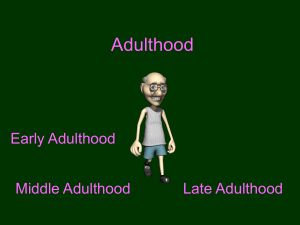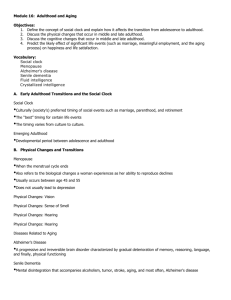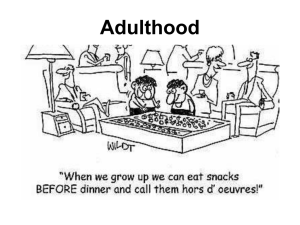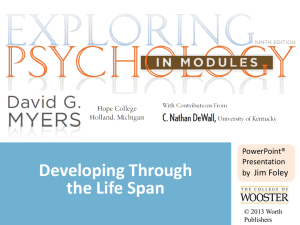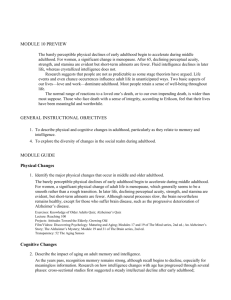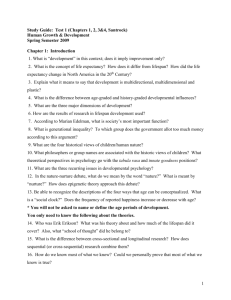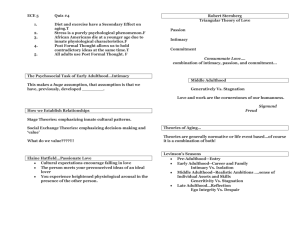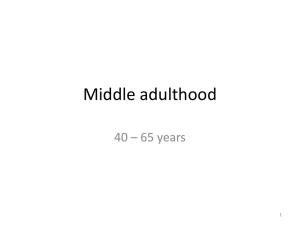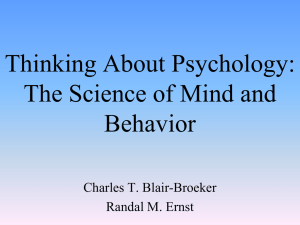Module 16 Adulthood, and Reflections on Developmental Issues
advertisement
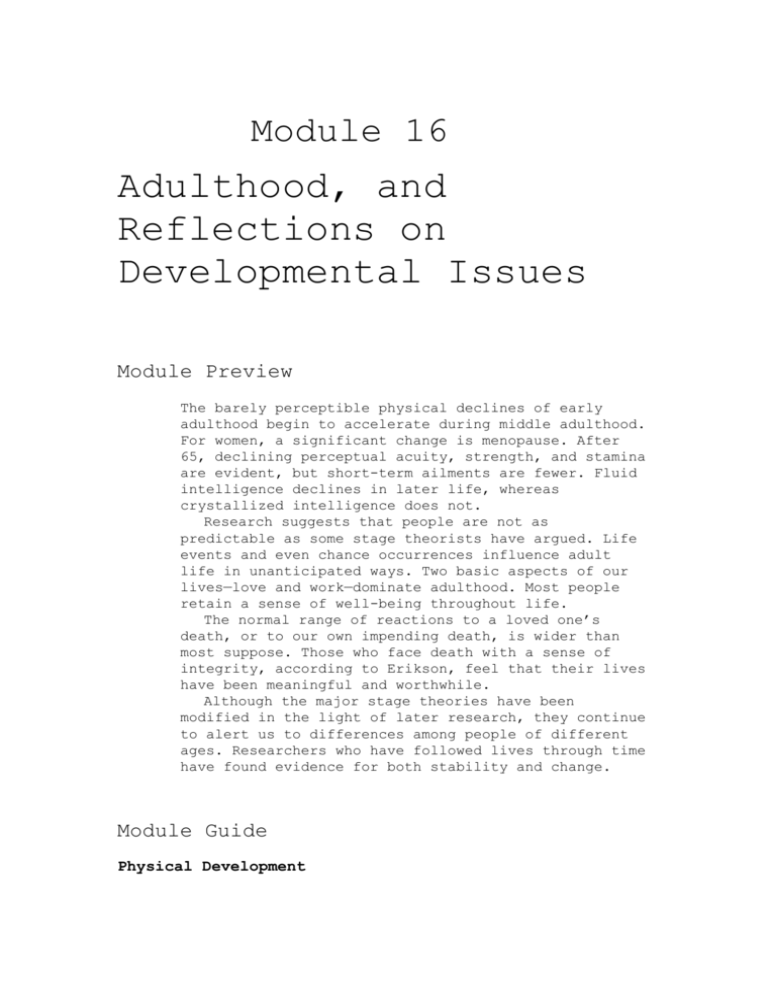
Module 16 Adulthood, and Reflections on Developmental Issues Module Preview The barely perceptible physical declines of early adulthood begin to accelerate during middle adulthood. For women, a significant change is menopause. After 65, declining perceptual acuity, strength, and stamina are evident, but short-term ailments are fewer. Fluid intelligence declines in later life, whereas crystallized intelligence does not. Research suggests that people are not as predictable as some stage theorists have argued. Life events and even chance occurrences influence adult life in unanticipated ways. Two basic aspects of our lives—love and work—dominate adulthood. Most people retain a sense of well-being throughout life. The normal range of reactions to a loved one’s death, or to our own impending death, is wider than most suppose. Those who face death with a sense of integrity, according to Erikson, feel that their lives have been meaningful and worthwhile. Although the major stage theories have been modified in the light of later research, they continue to alert us to differences among people of different ages. Researchers who have followed lives through time have found evidence for both stability and change. Module Guide Physical Development Lecture: 2002—American Perceptions of Aging in the Twenty-First Century Exercise: Alzheimer’s Quiz Exercise/Project: Is There a Prime of Life? Projects: Birthday Cards and Aging; Writing a Biography; Attitudes Toward the Elderly; Growing Old PsychSim 5: Signs of Aging ActivePsych: Scientific American Frontiers, 3rd ed.: Aging and Memory: Studying Alzheimer’s Disease; Digital Media Archive, 2nd ed.: The Development of Tangles and Plaques in Alzheimer’s Disease; Can the Immune System Be Used to Combat Alzheimer’s Disease? Videos: Discovering Psychology, Updated Edition: Maturing and Aging; Modules 17, 18, and 19 of The Mind series, 2nd ed.: Aging and Memory, Effects of Mental and Physical Activity on Brain/Mind, and Understanding Alzheimer’s Disease; Modules 19 and 31 of The Brain series, 2nd ed.: Alzheimer’s Disease and Brain Transplants in Parkinson’s Patients Instructor Video Tool Kit: Alzheimer’s Disease 16-1. Identify the major changes in physical and sensory abilities that occur in middle adulthood and later life. Muscular strength, reaction time, sensory keenness, and cardiac output crest in the mid-twenties and then slowly begin to decline. These barely perceptible physical declines of early adulthood begin to accelerate during middle adulthood. For women, a significant physical change of adult life is menopause, the ending of the menstrual cycle. A woman’s attitudes and expectations influence the emotional impact of menopause. Men experience no equivalent of menopause and no sharp drop in sex hormones. After middle age, most men and women remain capable of satisfying sexual activity. Life expectancy is affected by several factors. For example, with age, people’s chromosome tips, called telomeres, wear down. As this happens, aging cells die without being replaced. Also, the human spirit affects life expectancy as evidenced by the death-deferral phenomenon. In later life, declining perceptual acuity, muscle strength, reaction time, stamina, hearing, and the sense of smell are evident. Short-term ailments are fewer, but a weakened immune system makes lifethreatening ailments more likely. Neural processes slow, and compared with teens and young adults, older people take a bit longer time to react, to solve perceptual puzzles, and even to remember names. Exercising the body feeds the brain and helps compensate for the loss of brain cells. Some adults do suffer a substantial loss of brain cells, and up to age 95 the incidence of mental disintegration doubles roughly every 5 years. Alzheimer’s disease strikes 3 percent of the world’s population by age 75. Cognitive Development Lectures: Achievement in Later Life; Living to 100 Exercise: Selective Optimization With Compensation Instructor Video Tool Kit: Old Age: Thinking and Moving at the Same Time 16-2. Assess the impact of aging on memory and intelligence. As the years pass, recognition memory remains strong, although recall begins to decline, especially for meaningless information. Older adults may take longer than younger adults to produce the words and things they know. Older people’s capacity to learn and remember skills declines less than their verbal recall. Prospective memory (“remember to . . .”) remains strong when events help trigger memories. Without reminder cues, time-based tasks (“Remember the 8 a.m. meeting”) and habitual tasks, such as remembering to take medications, can be especially challenging. Cross-sectional studies, in which people of different ages are compared with one another, suggested that intelligence declines after early adulthood. Later, longitudinal studies, in which the same people are restudied and retested over a long period, reported that intelligence remained stable until late in life. While the cross-sectional studies failed to consider generational differences in income and life experience, longitudinal studies failed to account for those who dropped out of studies and who may have been less intelligent than the survivors. Furthermore, intelligence is not a single trait, and tests that assess speed of thinking may place older adults at a disadvantage because of their slower neural mechanisms for processing information. Today’s view is that crystallized intelligence—one’s accumulated knowledge and verbal skills as reflected in vocabulary and analogies tests—increases up to old age. Fluid intelligence—one’s ability to reason speedily and abstractly, as when solving novel logic problems— declines slowly up to age 75 and then more rapidly, especially after age 85. Social Development Lecture: Friendship in Marriage Feature Film: Tuesdays With Morrie Video: Module 23 of Psychology: The Human Experience: Stages of Adult Development Instructor Video Tool Kit: Healthy Aging: The Power of Positive Thinking 16-3. Explain why the path of adult development need not be tightly linked to chronological age, and discuss the importance of love, marriage, children, and work in adulthood. Some psychologists have suggested that adults progress through an orderly sequence of life stages. They argue, for example, that as people enter their forties, they undergo a midlife transition to middle adulthood, which, for many, is a crisis. However, research has failed to support the idea that distress peaks anywhere in the midlife range. Moreover, critics suspect that, given variations in the social clock and individual experience, any proposed timetable of adult ages and stages will have limited applicability. Marriage, parenthood, retirement, and other life events that make transitions to new life stages are occurring at unpredictable ages. Even chance encounters and events can have lasting significance and, as a result, adults may change far more, and far less predictably, than stage theories suggest. Two basic aspects of our lives dominate adulthood. Erik Erikson called them intimacy (forming close relationships) and generativity (being productive and supporting future generations). Evolutionary psychologists suggest that marriage had survival value for our ancestors in that parents who stayed together and raised children to a child-bearing age had a greater chance of passing their genes on to posterity. Compared with their counterparts of 40 years ago, people in Western countries are better educated and marrying later. Yet they are nearly twice as likely to divorce. Nonetheless, more than 9 in 10 heterosexual adults marry, and research indicates that married people are generally happier when compared with the unmarried. Often, love bears children. As children begin to absorb more and more time, money, and emotional energy, satisfaction with the marriage may decline. Most parents are happy to see their children grow up, leave home, marry, and have careers. For adults, a large part of the answer to “Who are you?” is the answer to “What do you do?” Choosing a career path is difficult, especially in today’s changing work environment. It frequently takes time for people to settle into an occupation. Most people shift from their initially intended majors, many find their postcollege employment in fields not directly related to their majors, and most will change careers. Happiness is having work that fits your interests and provides a sense of competence and accomplishment. Exercises: The Death-Bed Test; Thinking About Death Project: Preparing an Obituary 16-4. Describe trends in people’s life satisfaction across the life span, and describe the range of reactions to the death of a love one. Although the over-65 years are not totally unhappy, newer surveys suggest happiness is slightly higher among both young and older adults than among those middle-aged. If anything, positive feelings grow after midlife and negative feelings subside. Older adults increasingly use words that convey positive emotions. Moreover, the bad feelings we associate with negative events fade faster than do the good feelings we associate with positive events. As the years pass, feelings mellow and the highs become less high and the lows less low. More and more people flourish into later life, thanks to biological, psychological, and socialcultural influences. Usually, the most difficult separation is from one’s spouse. Grief is especially severe when the death of a loved one comes before its expected time on the social clock. The normal range of reactions to a loved one’s death is wider than most people suppose. Some cultures encourage public weeping and wailing; others hide grief. Within any culture, some individuals grieve more intensely and openly. Research discounts the popular idea that terminally ill and bereaved people go through predictable stages. Life itself can be affirmed even at death, especially if one’s life has been meaningful and worthwhile. Reflections on Two Major Developmental Issues Lecture: Resilient Youth Exercise: Personal Stability and Change 16-5. Summarize current views regarding continuity versus stages and stability versus change in lifelong development. Researchers who emphasize experience and learning tend to see development as a slow continuous process. Those who emphasize biological maturation tend to see development as a series of genetically predisposed stages. Although the stage theories of Piaget, Kohlberg, and Erikson have been modified in the light of later research, each theory usefully alerts us to differences among people of different ages and helps us to keep the life-span perspective in view. Research also suggests that lifelong development includes stability and change. The first two years provide a poor predictor of a person’s eventual traits; older children and adolescents also change. As people grow older, however, personality does stabilize. There is also an underlying consistency to most people’s temperaments and emotionality.

